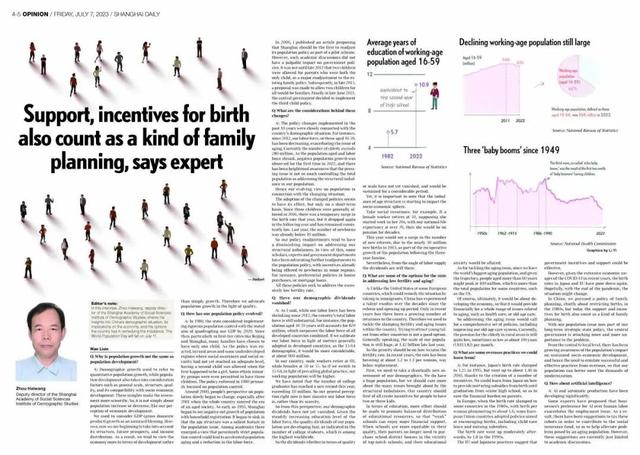转自:上观新闻

本文刊载于2023年7月7日《SHANGHAI DAILY》4-5 OPINION
Support, incentives for birth also count as a kind of family planning

Given the steadily increasing education level of the labor force, the quality dividends of China's population are developing fast, as indicated in the number of college students, which is among the highest worldwide, says expert.
In this interview, Zhou Haiwang, deputy director of the Shanghai Academy of Social Sciences Institute of Demographic Studies, shares his insights into China's demographic situation, its implications on the economy, and the options the country has in remedying the imbalance. The World Population Day will fall on July 11.
Why is population growth not the same as population development?
Demographic growth used to refer to quantitative population growth, while population development also takes into consideration factors such as general scale, structure, quality, and its compatibility with socio-economic development. These insights make the assessment more scientific. So, it is not simply about population increase or decrease, like our perception of economic development.
We used to consider GDP (gross domestic product) growth as an unmixed blessing. However, now we are beginning to take into account its structure, future prospects, and income distribution. As a result, we tend to view the economy more in terms of development rather than simply growth. Therefore we advocate population growth in the light of quality.

How has our population policy evolved?
In 1980, the state considered implementing rigorous population control with the stated aim of quadrupling our GDP by 2020. Since then, particularly in first-tier cities like Beijing and Shanghai, many families have chosen to have only one child. As the policy was enacted, in rural areas and some underdeveloped regions where social awareness and social security had not yet reached an adequate level, having a second child was allowed when the first happened to be a girl. Some ethnic minority groups were even permitted to have three children. The policy enforced in 1980 primarily focused on population control.
Around 2000, people's perspective on population slowly began to change, especially after 2001 when the whole country entered the era of an aged society. As early as 1993, Shanghai began to see negative net growth of population with household registration. It began to sink in that the age structure was a salient feature in the population issue. Among academics there emerged a view that persistently strict population control could lead to accelerated population aging and a reduction in the labor force.
In 2006, I published an article proposing that Shanghai should be the first to readjust its population policy as part of a pilot scheme. However, such academic discussions did not have a palpable impact on government policies. It was not until late 2012 that two children were allowed for parents who were both the only child, as a major readjustment to the existing family policy. Subsequently, in late 2015, a proposal was made to allow two children for all would-be families. Finally in late June 2021, the central government decided to implement the third child policy.
What are the considerations behind these changes?
The policy changes implemented in the past 10 years were closely connected with the country's demographic situation. For instance, since 2012, our labor force, or those aged 16-59, has been decreasing, exacerbating the issue of aging. Currently the number of elderly exceeds 280 million. As the population aged and labor force shrank, negative population growth was observed for the first time in 2022, and there has been heightened awareness that the pressing issue is not so much controlling the total population as addressing the structural imbalance in our population.
Hence our evolving view on population in connection with the changing situation.
The adoption of the changed policies seems to have its effect, but only on a short-term basis. Since three children were generally allowed in 2016, there was a temporary surge in the birth rate that year, but it dropped again in the following year and has remained consistently low. Last year, the number of newborns was already below 10 million.
So our policy readjustments tend to have a diminishing impact on addressing our structural imbalances. In view of this, some scholars, experts and government departments have been advocating further readjustments to the population policy, with incentives already being offered to newborns in some regions. For instance, preferential policies in house purchases, or mortgage loans.
All these policies seek to address the excessively low fertility rate.

Have our demographic dividends vanished?
As I said, while our labor force has been shrinking since 2012, the country's total labor force is still substantial. For instance, the population aged 16-59 years still accounts for 870 million, which surpasses the labor force of all developed countries combined. If we calibrate our labor force in light of metrics generally adopted in developed countries, as the 15-64 demographic, it would be more considerable, at about 960 million.
In our country, male workers retire at 60, while females at 50 or 55. So if we switch to 15-64, in light of prevailing global practice, our working population will be higher.
We have noted that the number of college graduates has reached a new record this year, exceeding 10 million. So our general perception right now is how massive our labor force is, rather than its scarcity.
So from this perspective, our demographic dividends have not yet vanished. Given the steadily increasing education level of the labor force, the quality dividends of our population are developing fast, as indicated in the number of college students, which is among the highest worldwide.
So the dividends whether in terms of quality or scale have not yet vanished, and would be sustained for a considerable period.
Yet, it is important to note that the imbalance of age structure is starting to impact the socio-economic sphere.
Take social insurance, for example. If a female worker retires at 50, supposing she started work in her 20s, with our national life expectancy at over 76, then she would be on pension for decades.
This year would see a surge in the number of new retirees, due to the nearly 30 million new births in 1963, as part of the recuperative growth of the population following the three-year famine.
Nevertheless, from the angle of labor supply the dividends are still there.

What are some of the options for the state in addressing low fertility and aging?
Unlike the United States or some European countries, which could remedy the situation by taking in immigrants, China has experienced a talent exodus over the decades since the reform and opening-up period. Only in recent years has there been a growing number of returnees to the country. Therefore we need to tackle the slumping fertility and aging issues within the country. Trying to attract young talent from other countries is not a good option. Generally speaking, the scale of our population is still huge, at 1.42 billion late last year.
So the priority should be on how to raise the fertility rate. In recent years, the rate has been hovering at about 1.2 to 1.3 per woman, way below replacement.
First, we need to take a drastically new assessment of our demographics. We do have a huge population, but we should care more about the many issues brought about by the structural imbalances. Our country should first of all create incentives for people to have two or three kids.
In terms of education, more effort should be made to promote balanced distribution of educational resources, so that "weak" schools can enjoy more financial support. When schools are more equitable in their quality, then parents no longer need to purchase school district houses in the vicinity of top-notch schools, and their educational anxiety would be allayed.
As for tackling the aging issue, since we have the world's biggest aging population, and given the trajectory, people aged more than 60 years might peak at 400 million, which is more than the total population for some countries, such as the US.
Of course, ultimately, it would be about developing the economy, so that it would provide financially for a whole range of issues related to aging, such as health care, or old-age care.
So addressing the aging issue would call for a comprehensive set of policies, including improving our old-age care system. Currently, the pension for the elderly in rural areas is still quite low, sometimes as low as about 100 yuan (US$13.82) per month.
What are some overseas practices we could learn from?
For instance, Japan's birth rate slumped to 1.25 in 1995, but went up to about 1.46 in 2010, thanks to the creation of a number of incentives. We could learn from Japan on how to provide nurturing subsidies from birth until graduation from senior high school, so as to ease the financial burden on parents.
In Europe, when the birth rate slumped in some countries in the 1980s, with birth per woman plummeting to about 1.6, some European Union countries adopted policies aimed at encouraging births, including child-care leave and nursing subsidies.
The birth rate went up moderately afterwards, to 1.8 in the 1990s.
The EU and Japanese practices suggest that government incentives and support could be effective.
However, given the extensive economic ravages of the COVID-19 in recent years, the birth rates in Japan and EU have gone down again. Hopefully, with the end of the pandemic, the situation might change.
In China, we pursued a policy of family planning, chiefly about restricting births, in the 1980s, but today the support and incentives for birth also count as a kind of family planning.
With our population issue now part of our long-term strategic state policy, the central government is attaching more and more importance to the problem.
From the central to local level, there has been growing awareness of the population's impact on sustained socio-economic development, and hence the need to emulate successful and effective practices from overseas, so that our population can better meet the demands of modernization.
How about artificial intelligence?
AI and automatic production have been developing significantly.
Some experts have proposed that businesses's preference for AI over human labor exacerbates the employment issue. As a result, there have been suggestions to tax these robots in order to contribute to the social insurance fund, so as to help alleviate problems posed by an aging population. However, these suggestions are currently just limited to academic discussions.
来源:上海日报
制作审核:院党委宣传部
(院科研成果传播办公室)
责任编辑:陈灿斌

VIP课程推荐
APP专享直播
热门推荐
收起
24小时滚动播报最新的财经资讯和视频,更多粉丝福利扫描二维码关注(sinafinance)










